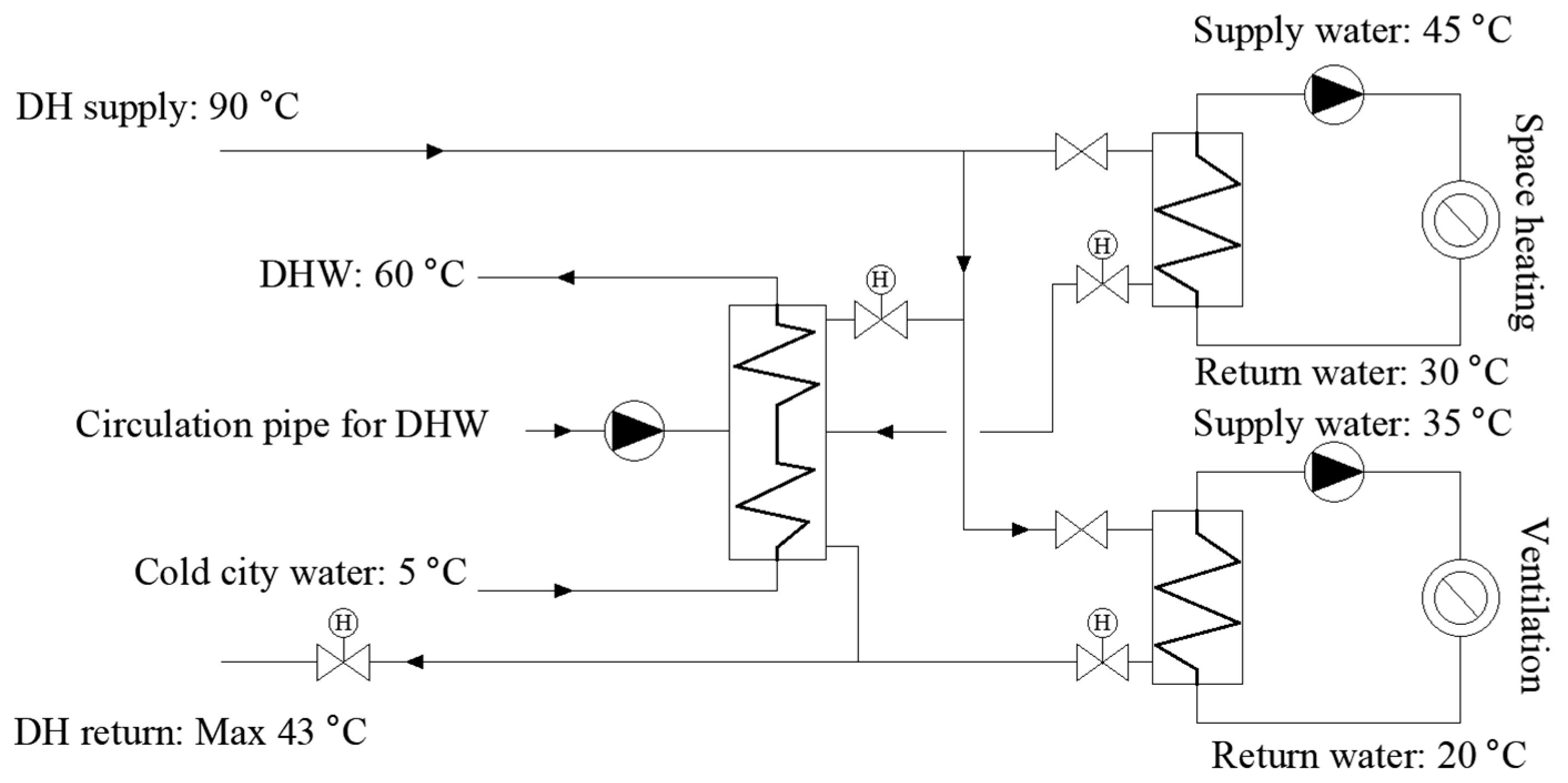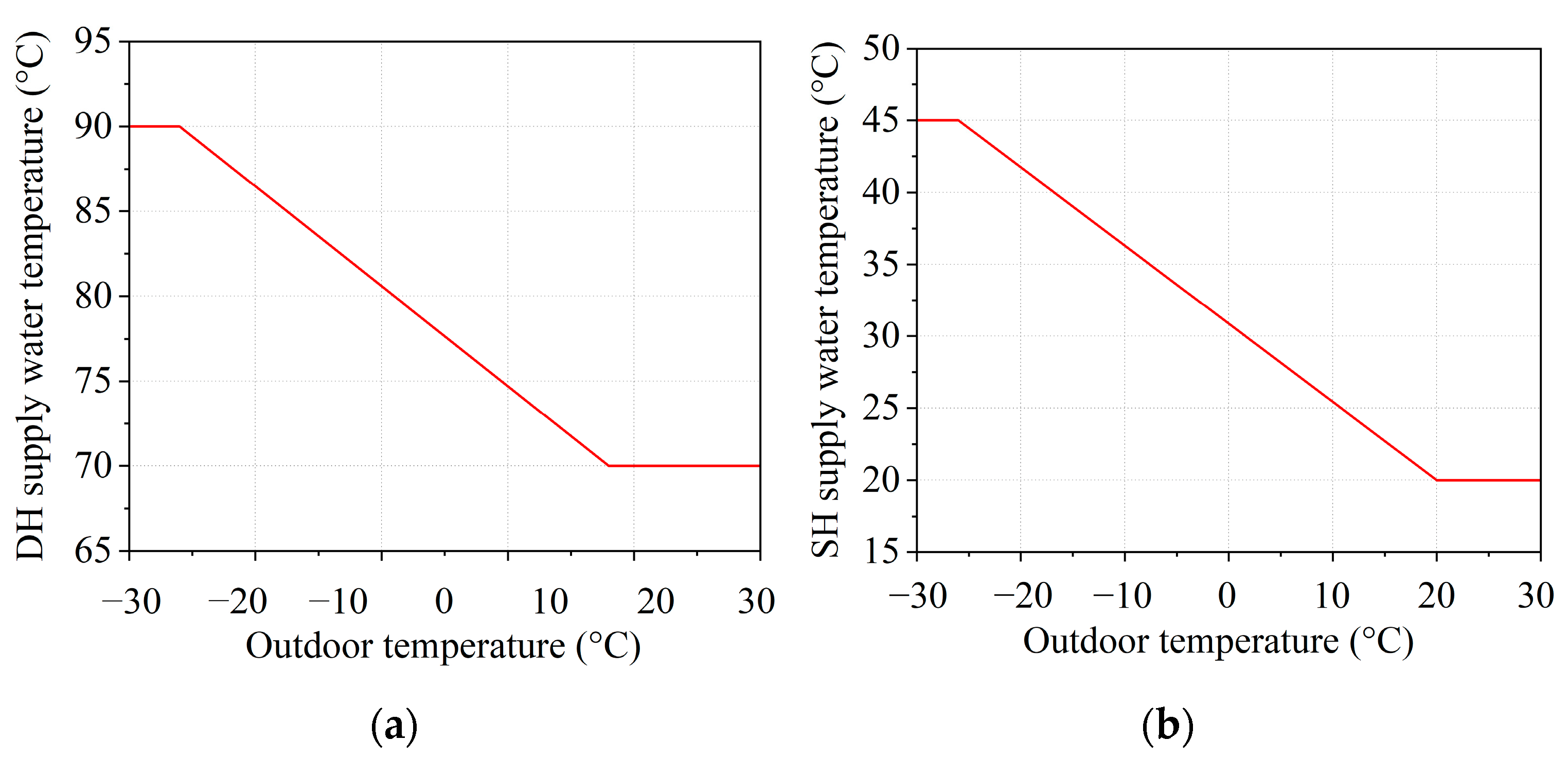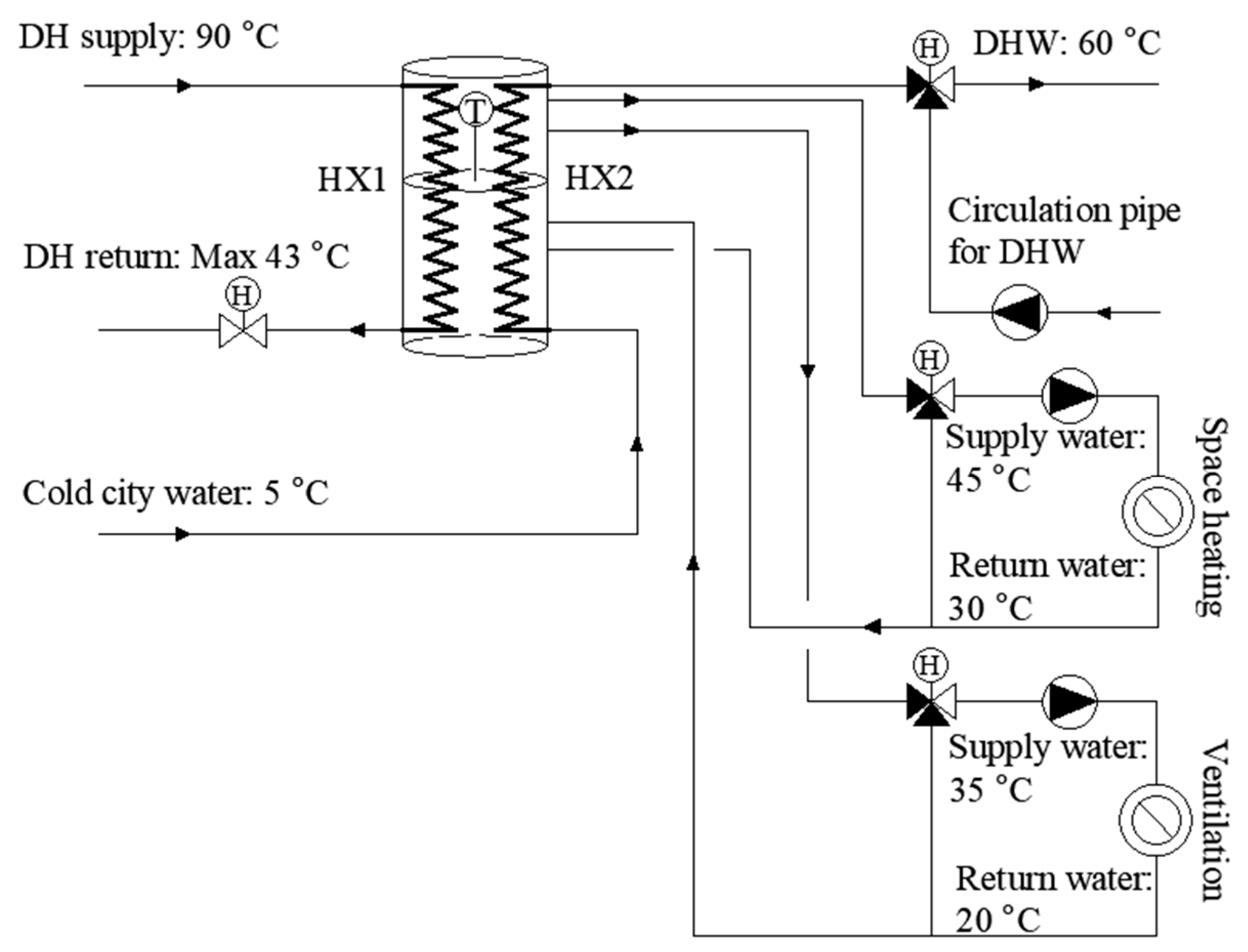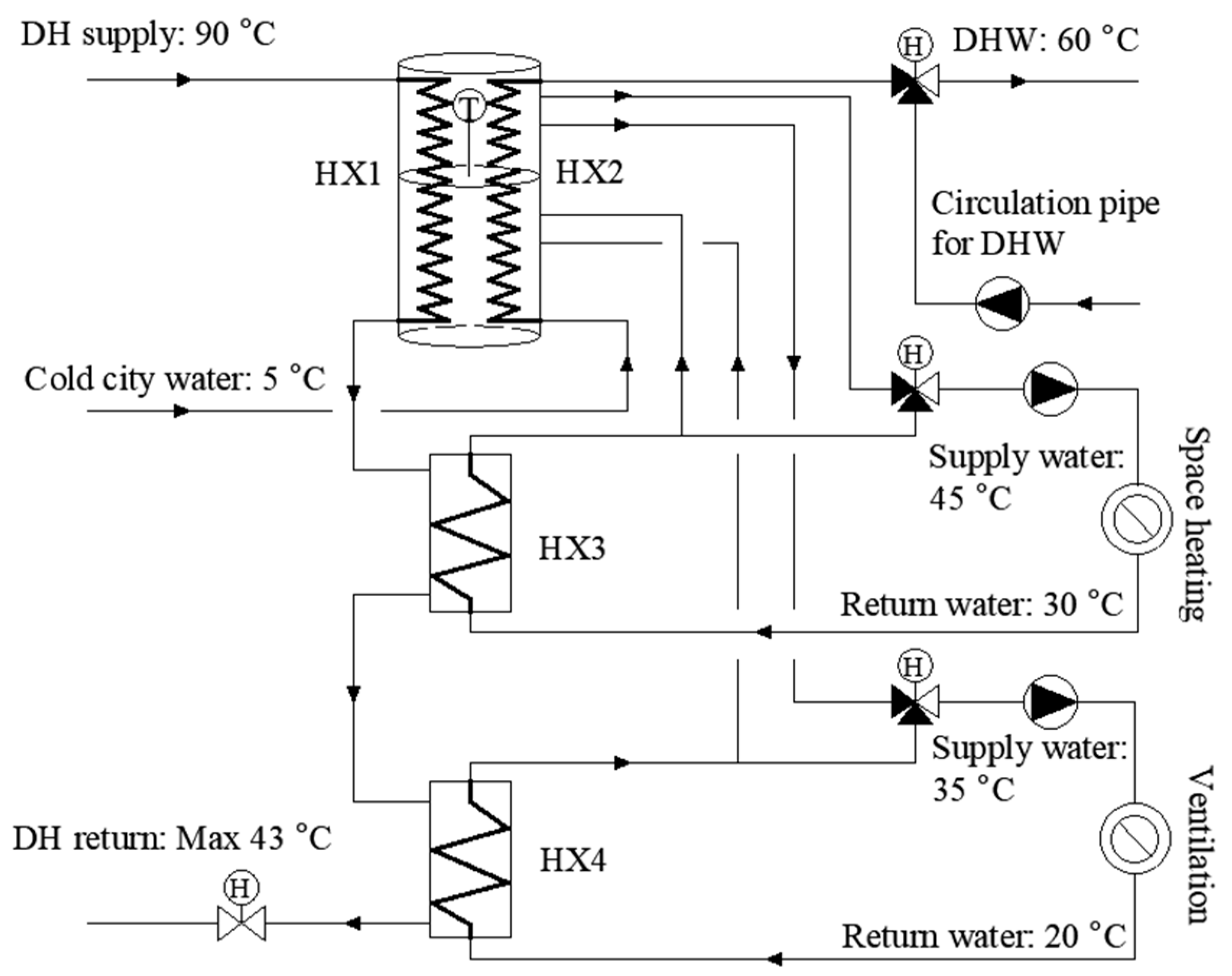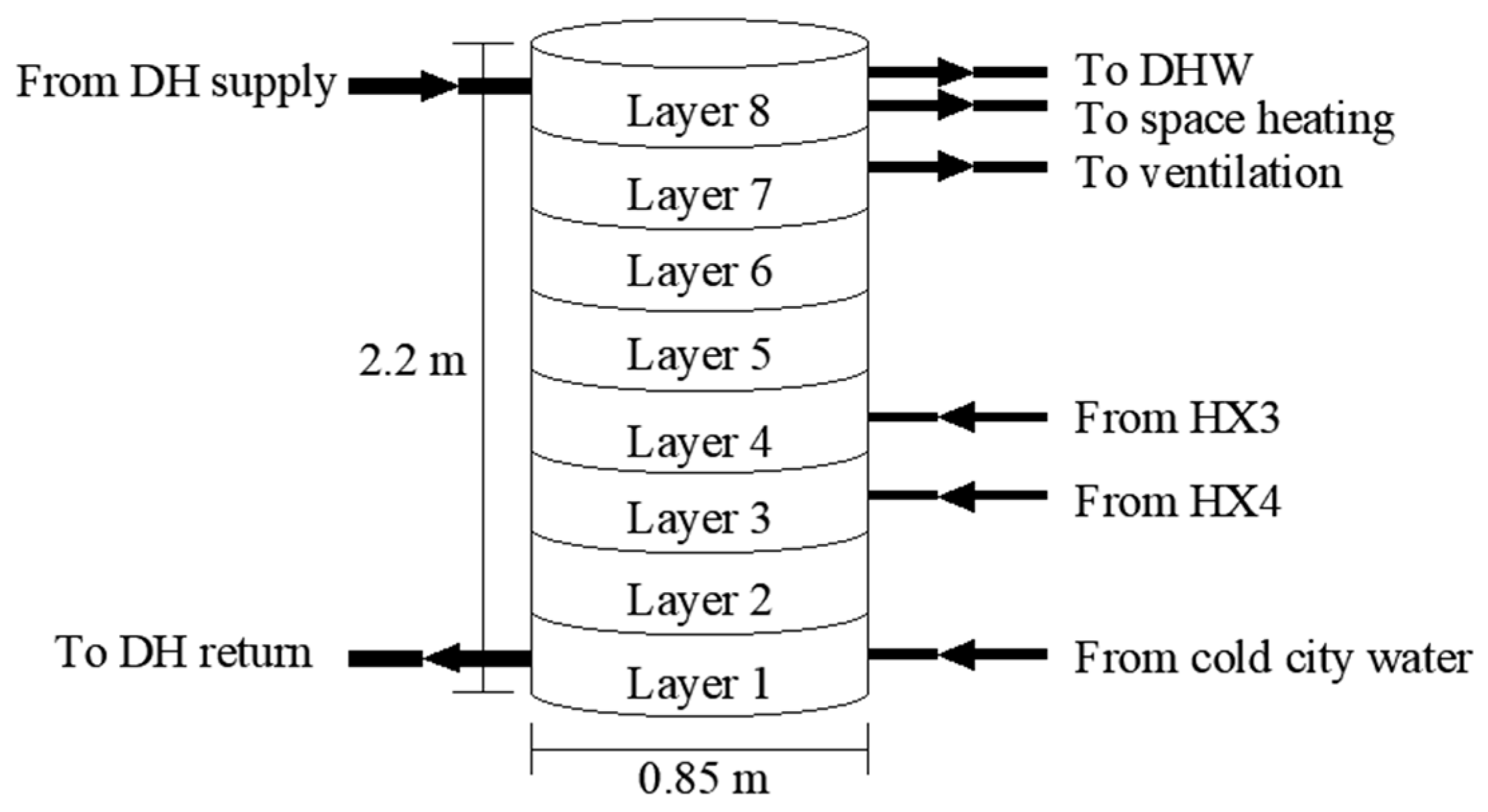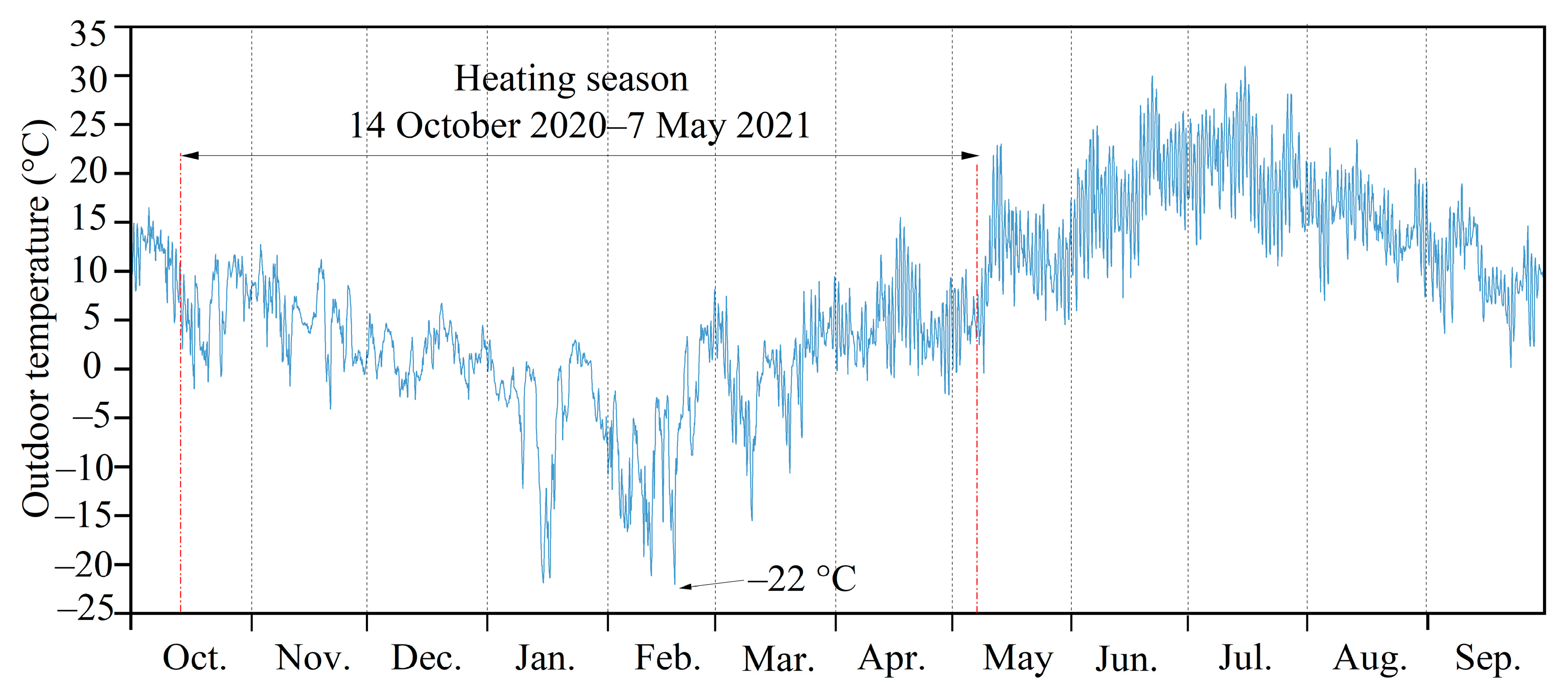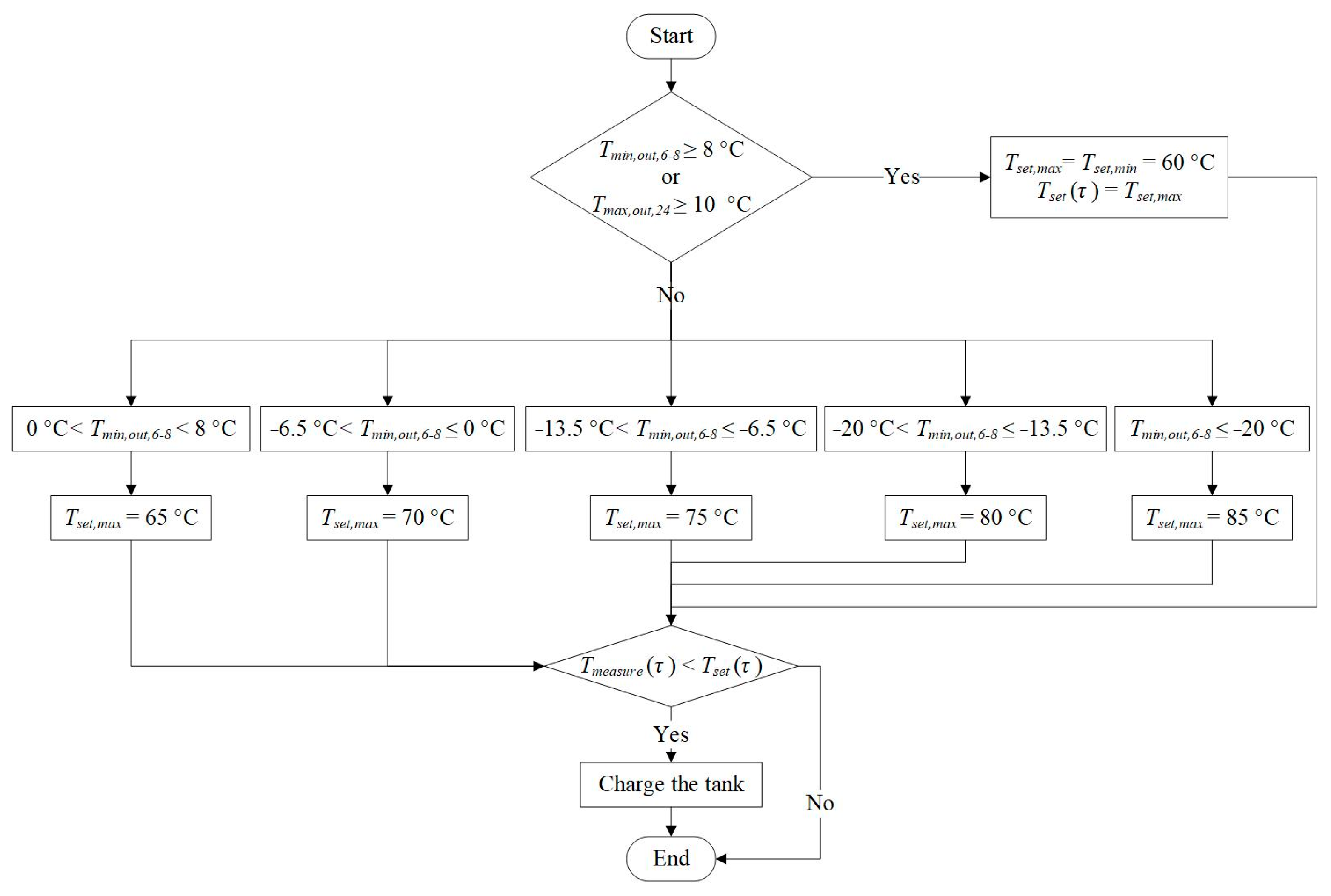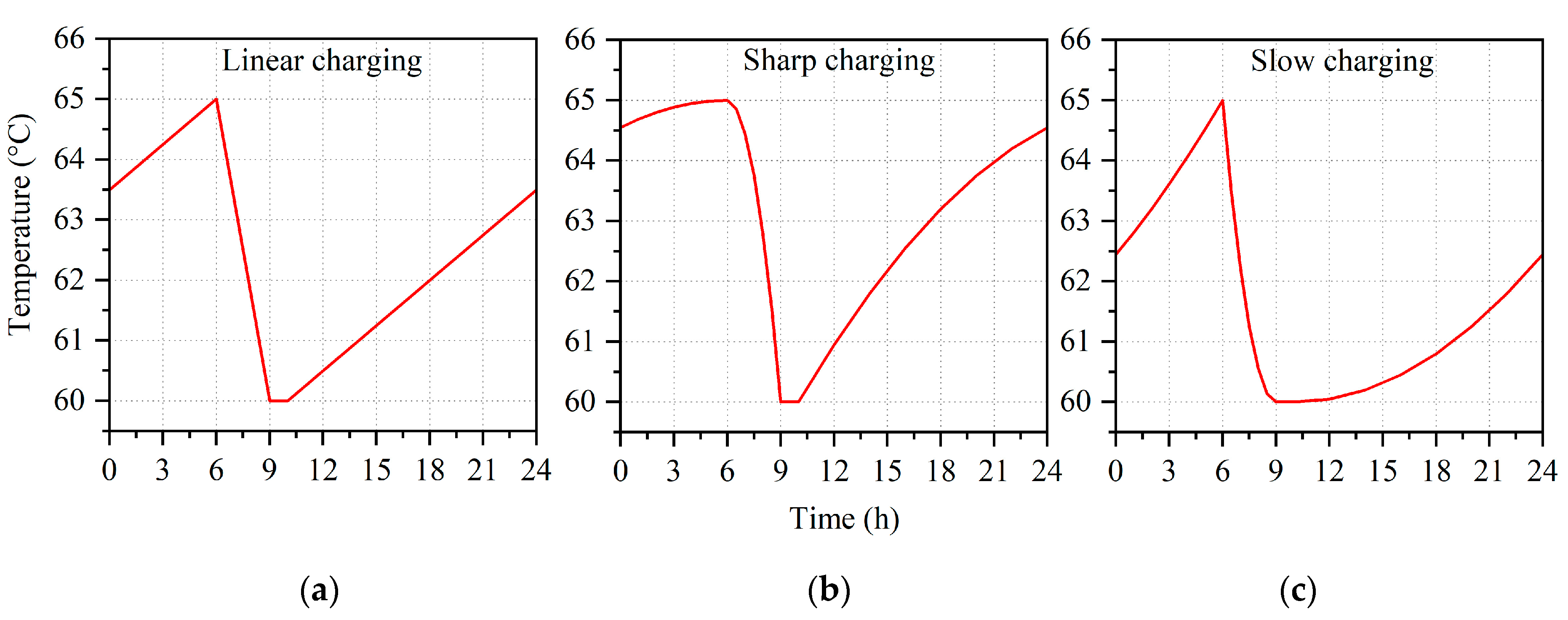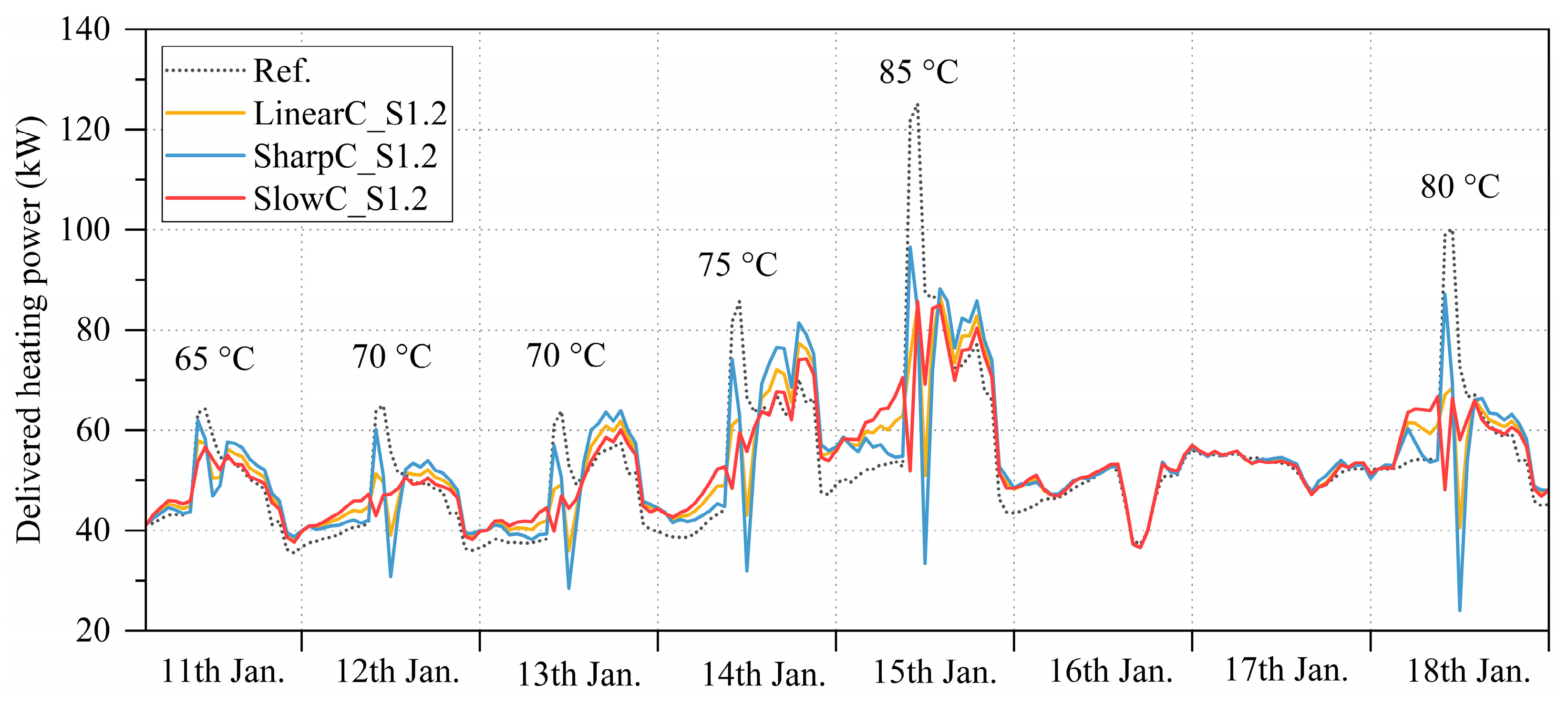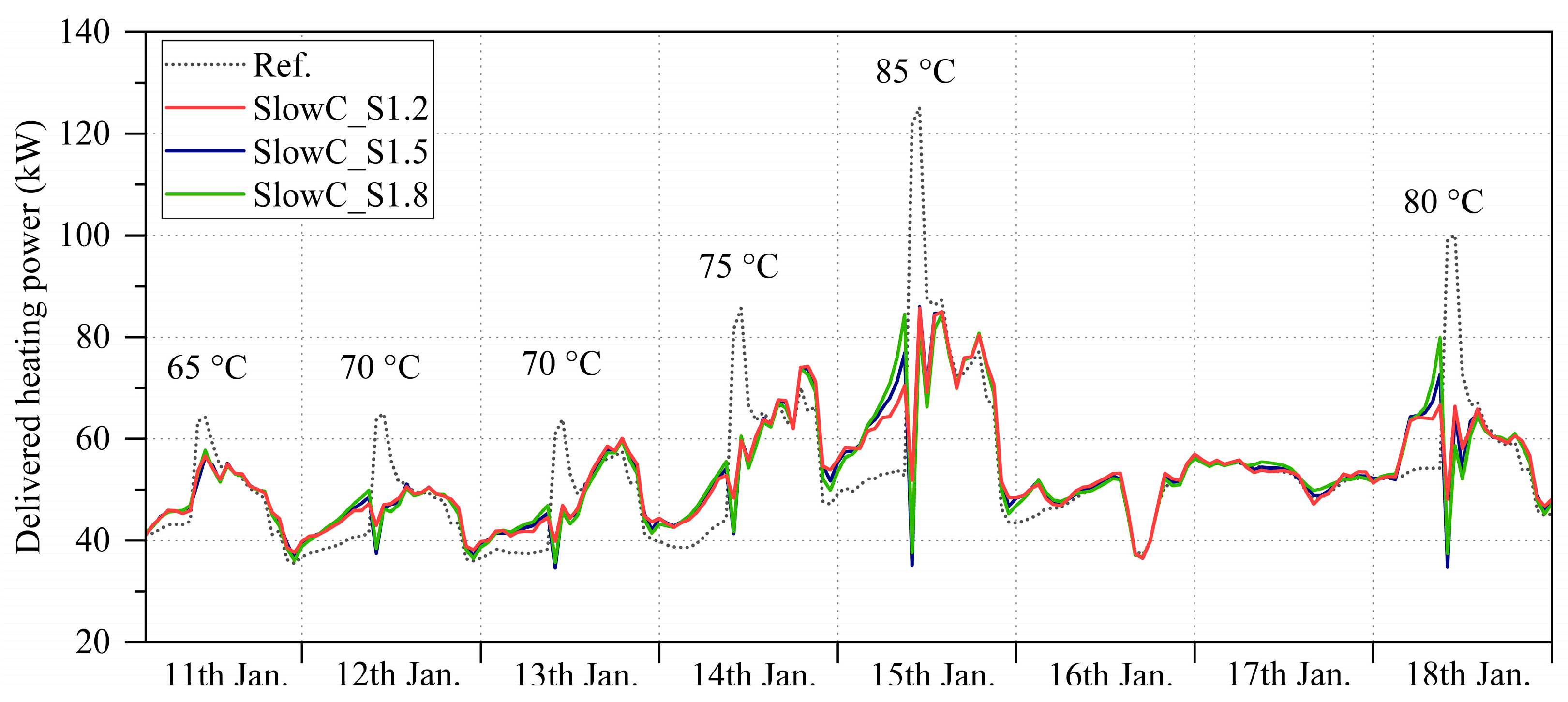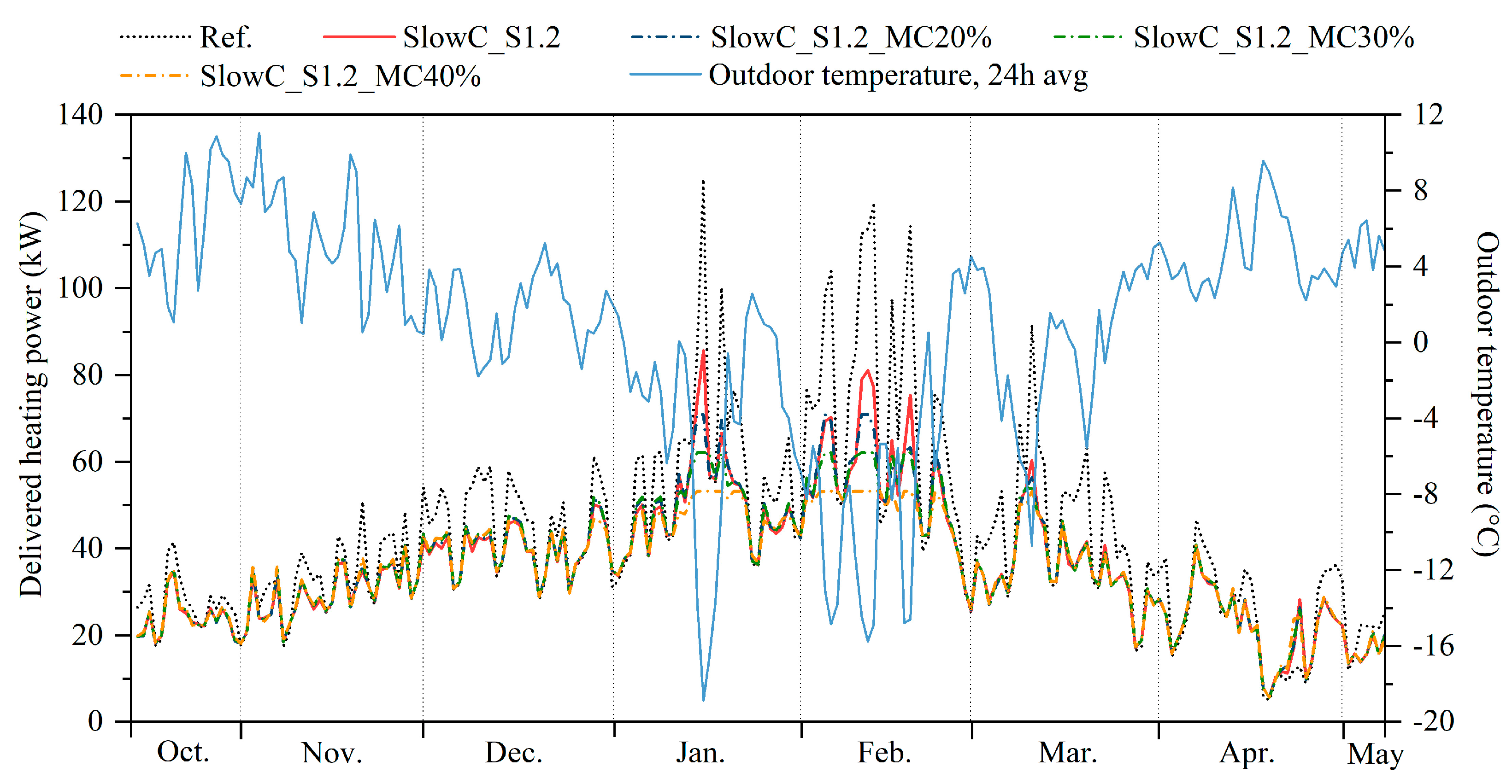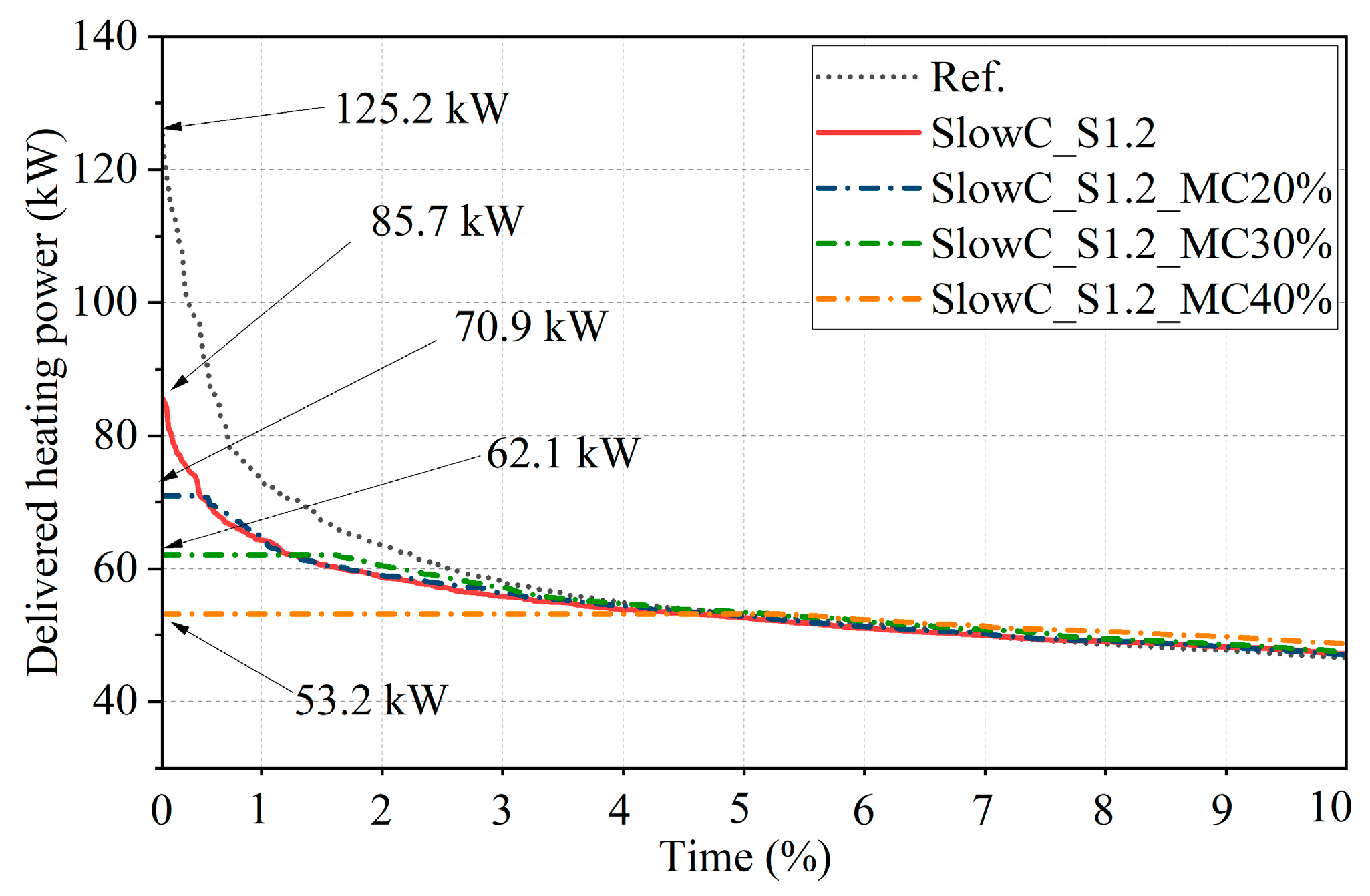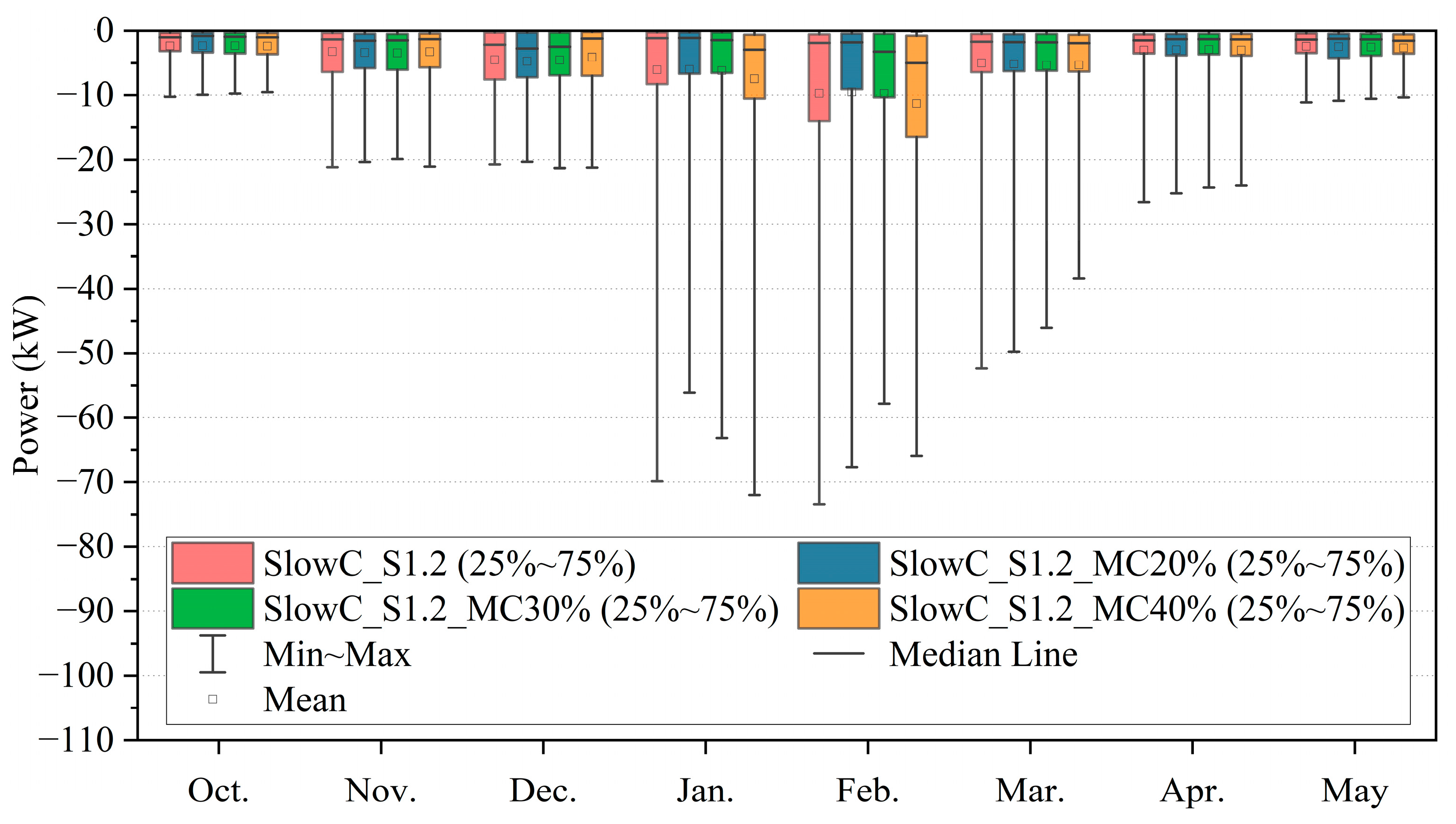1. Introduction
Global warming and climate change are globally the biggest issues of the present and the future. The portion of CO
2 emissions from the building sector is 36% in the EU [
1]. Although policies have been enacted to improve the energy efficiency of buildings, population and economic growth, urbanization, and other factors lead to an increase in energy consumption. For decreasing CO
2 emissions, the European Commission has set ambitious targets for cutting them by 40% from the 1990 level, increasing the share of renewable energy by 32%, and improving energy efficiency by at least 32.5% by 2030 [
2]. Finland also aims to reduce greenhouse gas emissions by at least 55% by 2030 compared to the 1990 level [
3]. In 2016, district heating (DH) was responsible for 33% of the energy consumption in Finland, and power and heat generation accounted for 40% of the total CO
2 emissions [
4]. District heat is the most common source which had 46% of space heating supply in 2018 and has covered over 60% of the heat supply for new buildings in Finland since 2015 [
5]. However, there was still approximately 50% of district heat generated by non-renewable sources [
5].
Besides improving the energy efficiency of buildings to reduce energy consumption and CO
2 emissions, integrating more renewable sources into energy supply systems is an alternative method to decrease the proportion of fossil fuels. However, variable generation schedules of some renewable sources on a large-scale supply may make energy systems unstable [
6]. Therefore, thermal energy storage (TES) could be an effective approach to providing flexibility. Other benefits could be gained such as peak shaving so that the maximum peak power reduces. In addition, the types and properties of TES such as capacity and store duration are considered when TES is employed in district heated buildings or DH systems.
For single buildings, one option is to utilize the building’s thermal mass as short-term TES for peak shaving. Cases mainly focus on pricing incentives (time of use rates, critical peak pricing, or real-time pricing) and related control algorithms to flatten the demand power curve [
7,
8]. Therefore, heat is charged in the building structures; for example, by controlling the temperature setpoints of space heating during low price periods or before peak power hours so that the indoor air temperature increases. When the energy price is high or it is during peak power periods, this part of the heat will be discharged to maintain the indoor air temperature. This strategy has been applied in buildings with both electricity and DH systems [
9,
10]. It can decrease the maximum peak power, vary the building demand, and save costs for prosumers [
11,
12,
13]. Moreover, there are several studies taking advantage of buildings’ thermal mass for the peak shaving and cost optimization of energy systems [
14,
15,
16].
For DH systems, sensible heat TES with water medium has an extensive application due to low cost, technological simplicity, thermal properties, etc. [
17]. For short-term TES, the most widely used type is to integrate it into the network production side with CHP or other units for centralized control [
17,
18,
19]. Different from the long-term TES to store the energy for several months, short-term TES is charged and discharged for a couple of hours to a few days [
20]. Usually, a larger sized storage is required so that the DH network capacity cannot be changed [
17]. Peak shaving can be realized so that the total generation capacity decreases [
21]. Li et al. [
22] found that the more the storage capacity of a centralized TES increased, the more the peak load was shaved in the DH system. Jebamalai et al. [
23] analyzed that centralized storage gained higher cost savings in a DH network with smaller peak daily profile variations while substation level storage was more suitable for high daily peak profile variations. In addition, solution methods such as mixed-integer linear programming (MILP) with objective functions were proposed for the optimal operation and savings of energy generation components among various candidates [
24,
25]. Benalcazar [
26] investigated the optimal capacity of TES units integrated into coal-fired CHP systems considering investment and units operation. It was found that the TES could both reduce the peak demand and mitigate environmental and fuel costs of heat-only boilers in the system. Tan et al. [
27] proposed an economic solution for a DH system considering arbitrage in electricity and reserve markets, which shaved the peak load with TES and reduced the total investment and operational costs.
In addition, because of the renewable energy integration and transition of ultra- or low-temperature DH, TES has usually been equipped in substations with heat pumps and other renewable units to supply heat to district heated buildings [
28,
29,
30]. Savolainen and Lahdelma [
31] developed a model for optimizing the renewable energy solutions of a hybrid energy system including DH, PV, ground source heat pumps, power storage batteries, and heat storages for districted heated buildings. Moreover, many cases mainly consider that the peak heating load was primarily determined by domestic hot water (DHW). Zhang et al. [
32] established a low-temperature DH network with a fixed 55 °C supply of water temperature. A 27.9 m
3 DHW tank was installed in the substation for the heat supply of residential buildings. After optimization by an objective function for peak load shifting to off-peak hours, the DHW tank application had a 5% peak load reduction and an annual cost-saving rate of 2.4%. Yang and Svendsen [
33] proposed a control strategy for a DHW tank for peak load shaving in a Danish residential building which was connected with a high-temperature DH system. They also considered the stratification of the storage tank and DH return temperature, but the DH supply temperature was assumed to be a constant.
For ultra-low temperature DH, preheating of the tank is required by heat pumps or electric heaters to guarantee the required supply temperature level, especially for DHW usage. A preheating strategy of a water tank for DHW was applied considering the coupling with electricity grids, such as electricity load, dynamic electricity prices, PV generation potential, etc. [
34,
35]. Several studies proposed control strategies to heat low-temperature DH water by heat pumps and preheat water tanks based on dynamic electricity price variations to decrease the peak power of DH or electricity [
36,
37].
However, in most cases, especially at district-level TES integration, they used simplified storage tank modeling [
24,
38]. Temperature stratification was not taken into account. However, temperature stratification in TES can vary a lot [
39]. Thus, the capacity of it might be overestimated in practice. Therefore, studies have proposed approaches to model stratification in TES more accurately [
40,
41]. Moncho-Esteve et al. [
42] investigated parameters that affected the degree of stratification. Hermansen et al. [
43] established a detailed DHW storage tank considering stratification and designed a rule-based control according to peak DH demand periods to charge it.
Based on the research mentioned above, most studies aim at short-term TES optimization with DH production units such as CHP or an application in ultra- or low-temperature DH substations. Very few cases considered the maximum allowed DH return water temperature and variation of supply temperatures when designing storage tank charging control strategies in conventional high-temperature DH networks. In addition, most cases focus on developing short-term TES control strategies for reducing DHW peak heating power in residential buildings.
Thus, the novelty of this study is that, firstly, a hot water storage tank was integrated into a conventional high-temperature DH substation to shave the peak power demand caused by the ventilation systems of a Finnish office building. Secondly, the storage tank was directly charged by the DH supply water with varied temperatures changed with outdoor temperatures. Moreover, stratification of the storage tank model was taken into account. The peak shaving control strategies were designed considering varied DH supply water temperatures and charging the storage tank properly to guarantee that the maximum primary return water temperature was within the required level simultaneously. The analysis also focuses on different water temperature control strategies and peak power cutting effects on heating power variation and peak shaving. Peak power cutting was realized by limiting the mass flow of the primary DH supply water. The rest of the paper is organized as follows.
Section 2 introduces the DH substation layouts and three temperature control algorithms for peak shaving.
Section 3 summarizes the location changes of the water tank temperature control sensor on peak shaving and analyzes the impact of different water temperature control curve characteristics and peak power cutting on heating power variation. Finally,
Section 4 discusses the further implication of this study and
Section 5 concludes the main findings.
4. Discussion
To decrease CO
2 emissions and realize climate neutrality, flexible buildings in a DH network are essential for increasing the proportion of intermittent renewable energies. The results indicate that the application of short-term TES significantly decreases the office building daily peak power caused by the ventilation system’s morning start during the heating season. In addition, peak power cutting provides a further decrease of the DH peak power demand. It is beneficial for Finnish consumers because of the power fee [
60]. The yearly power fee is charged based on the annual DH peak power level. Therefore, the higher the DH peak power demand of a building, the more the Finnish consumers pay for power fees. Therefore, it could decrease costs for consumers.
For DH producers, the large-scale application of the integration of short-term TES into substations for peak shaving decreases the need of the total generation capacity, which could become economically and ecologically profitable. On one hand, less delivered power would be transported from plants to substations during peak-power periods because the short-term TES is in there. As a result, pipe sizes for transportation could be reduced while heat distribution pipes in buildings from a substation to room units and air handling units could remain the same. On the other hand, since urbanization is accelerating, the number of heating consumers is gradually increasing. It will eventually cause the existing heating system to be unable to meet the rising heat demand. Since peak shaving by short-term TES reduces the peak power demand of DH systems, more consumers could be connected to the same generation network. DH producers may gain more profits from more customers while saving money on new or replacement generators.
What is more, it indicates that the large-scale application of short-term TES into substations could be an effective strategy to replace fossil fuels with renewable energy sources and improve the performance of DH units’ operation. DH producers would pay less expenses for CO2 emissions.
This paper mainly focuses on analyzing the impact of different water temperature control curve characteristics on heating power variation and peak shaving potential by TES and peak power cutting. Therefore, DH energy cost savings and investment costs of the facilities were not considered in this paper. A building owner who typically owns the substation pays for short-term TES installation. DH peak power demand has an impact on a power fee for building owners. In addition, DH producers save expenses for CO2 emissions, gain revenues from better system performance, and have more possible connected consumers because of the short-term TES application. Therefore, the DH energy cost savings both for building owners and DH producers, payback period, and life cycle cost (LCC) analysis should be carried out in further studies considering DH energy prices, DH power fees, investment, etc.
Through the establishment of the substation model, it indicated that considering the limitation of the DH return water temperature, the short-term hot water storage was not allowed to be fully charged. The most proper option was only to charge the amount of heat that could meet the peak shaving purpose unless the primary return water temperature could exceed the maximum allowed temperature. Charging more heat in the storage tank means that there is extra heat that is not supplied to the building so the return water temperature increases. Furthermore, it will cause a more serious rebound effect. In addition, the outdoor temperature variation should be taken into account. The outdoor temperature varied during the day. Usually, it reached the maximum temperature in the afternoon. The DH return water temperature could be higher than the limitation when charging the thermal storage during the daytime. Therefore, the charging time of the storage should be controlled with consideration of the outdoor temperature variation.
The maximum allowed primary return water temperature of 43 °C used in this study is based on the Finnish guideline [
50]. However, according to different guidelines or DH systems in different countries, the maximum allowed temperature could be varied. For example, in Germany, the maximum allowed temperature could be lower than 40 °C when the primary supply water temperature is 70 °C [
61]. For low-temperature DH in Germany, Denmark, Finland, Norway, and Great Britain, the maximum allowed return water temperatures could be 25 to 40 °C with 40 to 60 °C supply water temperature [
61]. Thus, the control strategies for short-term TES charging need to be adjusted to different maximum allowed temperature levels.
Similarly, the minimum acceptable indoor air temperature (20 °C) of this study was set based on the Finnish building code [
45] and it also fulfils the thermal environment category II of the EN 16798-1 standard [
46]. According to this study, the minimum acceptable indoor temperature is violated when the peak power is cut by 40% and the DHW supply water temperature cannot be guaranteed during these periods. However, considering different national guidelines, the minimum acceptable indoor air temperatures could be different. For example, in France, the upper limits of the heating temperature are recommended to be, on average, 19 °C for office buildings during occupied hours [
62]. Therefore, local guidelines and target values of the acceptable indoor air temperature range need to be taken into account to determine a proper peak power limiting degree.
There are many factors that could affect DH return water temperature which is mainly related to the return temperature from the short-term hot water storage. For example, the change of primary supply mass flow, heights of space heating, ventilation, and DHW inlets and outlets connected to storage, or dimensioning of heat exchangers will increase or decrease the return water temperature. The parameters chosen in this study are specific to the characteristics of the studied office building and the DH substation configuration. However, the water tank temperature control strategy of charging and discharging could be applied to other district heated buildings in other cold regions. It could decrease the peak power caused by space heating, ventilation, DHW, or a combination of them. The selection of the storage tank size mainly considered the installation conditions of the actual building. For further study, tank size optimization should be taken into account.
5. Conclusions
The aim of this paper is to shave the district heating peak power of a Finnish office building by short-term thermal energy storage without exceeding the maximum allowed district heating return water temperature. The district heating return water temperature changed after the installation of the return water heat exchangers were first analyzed. After that, the different water temperature control strategies, water tank temperature location change, and peak power cutting effects on the heating power variation and peak shaving potential were investigated and flexibility factors were employed to describe the short-term TES charging and discharging potential. Detailed conclusions are listed below:
The installation of return water heat exchangers can decrease the district heating return water temperature so that it guarantees that the return water temperature cannot exceed the Finnish maximum allowed limitation of 43 °C.
Linear and slow storage tank charging control curves can effectively help to decrease the district heating peak power demand, especially on colder days while the sharp charging curve does not respond on time for peak cutting on warmer days. The slow charging curve controls the water tank to store more heat at night. Therefore, for the purpose of flattening the heating power curve, the slow charging curve behaves better than the linear one. In addition, a lower sensor position is more suitable to increase the storage capacity and guarantee enough heat for discharging.
The application of short-term thermal storage with slow charging control effectively decreases the daily maximum peak power during the heating season. The maximum peak power of the case with slow charging decreases by 39.5 kW compared with the reference, which is about 31.5%. The lower the outdoor temperature is, the greater the daily maximum peak power reduces. In addition, peak power cutting by around 30% provides an additional peak power reduction without sacrificing thermal comfort.
In summary, installing TES to a substation is useful for decreasing the daily maximum peak power during the heating season. Through the analysis of flexibility factors, more power is shifted from high-peak periods without causing additional peaks. In addition, compared with the reference office building without TES, it reduces, at most, 50% of the DH peak power demand by peak power limiting without sacrificing thermal comfort.
